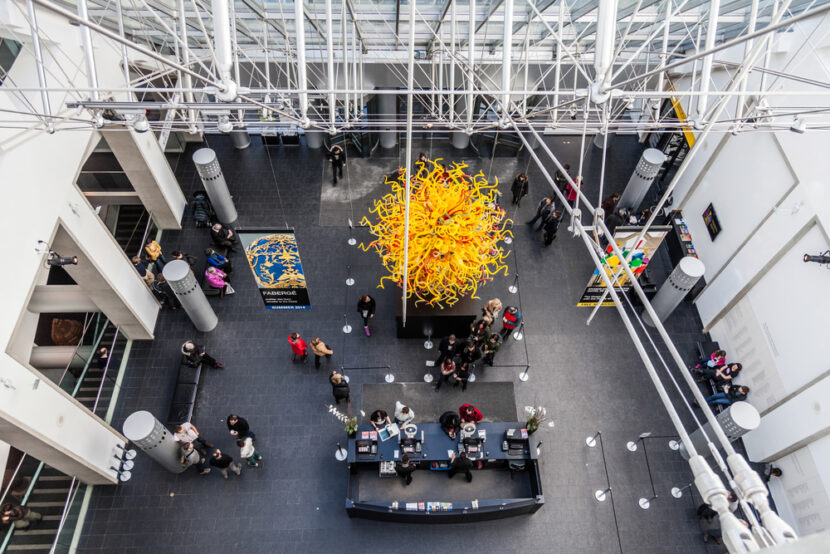MONTREAL – Walking through the new Montreal Museum of Fine Arts exhibit on impressionist and expressionist paintings in the period before the First World War is a bit like hearing humanity’s last gasp before it plunges into a nightmare.
The years before the war began in 1914 are usually recalled as an era of sabre-rattling and diplomatic tension.
“Van Gogh to Kandinsky: Impressionism to Expressionism 1900-1914” is a reminder that it was also a time of unprecedented creativity.
That’s obvious in the works on display from Vincent van Gogh, Wassily Kandinsky, Paul Gauguin, Ernst Ludwig Kirchner, Paul Cezanne, Pablo Picasso – and many others – in the breathtaking show.
“We’re really talking about what are perhaps the biggest names in modern art,” said Anne Grace, the curator of modern art at the museum.
More than 100 paintings and as many drawings and prints make up the exhibit, which runs to Jan. 25.
Hundreds of photographs, stereographic images and magazines are also used to illustrate the historical context of the era when an extraordinary cross-current between artists in Germany and France spawned major developments in modern art.
“This is an exceptional story because from 1900 to 1914, at the same time France and Germany were motivated by revenge and war, you can really see how the artists wanted to dialogue and wanted to share their esthetic emotions, their thoughts,” noted Nathalie Bondil, director and chief curator of the Montreal Museum of Fine Arts.
“In art history, when we look at this era, we look at two separate narratives and what the exhibition wants to show is that it wasn’t this separate narrative, but in fact expressionists in both France and in Germany were really mounting an international reaction to impressionism. They were united in their goals in wanting to have a very subjective, emotional way of painting.”
She noted that German expressionism is generally thought of as a very tortured art style, but the show adds a new dimension to it.
“What we see with this show is actually these artists in their youth,” Grace said. “They were 21 years old, 24 years old and it was all about life and expressing that passion for life through colours, through paint.
“There’s this real energy that I think these paintings communicate directly that was a very privileged moment that we mourn as soon as we end the exhibition.”
Indeed, the rooms of the exhibit are light and the paintings colourful until you come to the conclusion of the show. The last room is painted in darker colours and the sound of marching feet is audible from the following section on the First World War, where the lights are dimmed further.
“We must promote the beauty and make the meaning of the exhibition very clear, not only for your brain but also for your eyes and your guts,” said Bondil. “There are different levels for saying our message.”
Many of the artists would go on to serve in the First World War. Not all would survive, and of those that did some would carry deep emotional scars.
The show not only foreshadows the First World War but has resonance in the Second World War as well. Many of the artists would be persecuted by the Nazis as so-called degenerates.
“Van Gogh to Kandinsky” is not the only exhibit at the museum to mark the 100th anniversary of the start of the First World War this year.
“The Patriotism of Death: Propaganda Posters From World War I” will open on Nov. 11 and run until Feb. 8. The 20 large posters show how governments in Canada, France, England, Germany and the U.S. drummed up contributions to the war effort from their citizens.
The era highlighted in “Van Gogh to Kandinsky” is marked as well by significant advances in technology such as the expansion of rail lines that would prove key in the First World War. It was also a period where empires began to collapse and new nations emerged.
“All of history in that moment allowed this burst of creative energy,” said Timothy Benson, curator of the Robert Gore Rifkind Centre for German Expressionist Studies at the Los Angeles County Museum of Art, of the paintings in the show.
The Los Angeles County Museum of Art was one of the two other venues where the show was mounted before. It was also seen at the Kunsthaus Zurich in Switzerland.
“It’s always exciting for us to bring the paintings together in one place,” said Benson.
“It’s almost like (being) a kid in a candy store when the crates come and you get to open the crates up and put the paintings in a kind of array that’s unprecedented.”
Benson pointed out that the Montreal show is important not only because of its content but because some of the paintings are becoming fragile, making them more difficult to borrow. He also noted transporting such objects is not getting any cheaper.
“These paintings will never be put together again,” Benson said.
